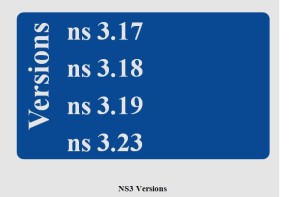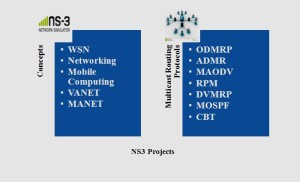IEEE NS3 Projects
IEEE NS3 Projects(NS3 )is a type of network simulator which is used to design set of objectives for various cores of network application. We ensure NS3 as a simulation environment gives libraries and tools to design large area network. We offer IEEE NS3 projects which is useful for college students to carry over their projects. We support and develop IEEE based simulation projects for post graduate and undergraduate final year students. We design & develop multicast routing protocols by NS3 simulation tool. We analyzed NS3 modules by multicast protocol such as ODMRP and ADMR. We test location based module and location aware protocol are evaluated by NS3 simulator model. We developed more than 80 various applications in wireless network projects by NS3.
multicast routing projects:
We produce on demand multicast routing protocol with rich connectivity among multicast group members. We make mesh to ensure high data delivery ratio. We introduce forwarding concept in ODMRP to construct mesh & mobility prediction method. We send a joint message with data payload piggybacked from source node. Joint node create periodically flooded to entire network ensure on membership information. In a network every interest node will respond to join message. We make multicast paths bysender & share by other sender in network.
GPS process in ODMRP:
We support ODMRP scheme with mobility prediction scheme to find most stable path among sender & receiver main purpose of join message flooding to refresh network. We use global positioning system (GPS) to get link expiration time among two connected nodes. Receiver send reply message to sender by having maximum link expiration time.
Advantages of ODMRP:
We attain following factors in ODMRP are:
- Give shortest path to reduce delivery latency.
- Use mobility prediction scheme to reduce control overhead.
- Ensure effective forwarding group concept.
ADMR protocol:
We implement adaptive demand driven multicast routing and routing protocol in Adhoc network for multicasting purpose. It works as on demand sender tree based protocols which adapt behavior of data sending pattern. ADMR does not require periodic neighbor detection. Periodic routing table exchange and periodic flood control. We determine application layer behavior which permit efficient detection of link breaks and expire routing table exchanges in MS projects.
Multicast tree in ADMR:
We create multicast tree when group sender create multicast packet for first time. Every multicast packet composed of average packet arrival time from sender application layer. We use inter packet arrival time to predict next packet arrival time. When application layer does not create new packet then routing layer send keep alive packets to maintain multicast tree. We provide tree based routing protocol to defeat overhead & increase network efficiency. We generate & transmit multicast packets by optimized route.
Advantages of ADMR:
- Mobility change adopted by ADMR.
- Application data sending pattern in ADMR to avoid periodic control message.
Related Pages
- Computer network security projects
- IEEE Wireless sensor network PROJECTS
- B.TECH IEEE PROJECTS 2016
- M.Tech IEEE Projects 2016
- IEEE ANDROID PROJECTS
- Wireless sensor network ns2 code
- Cloud computing IEEE project papers
- IEEE papers on computer science
- FINAL YEAR PROJECT FOR CSE
- CSE projects for final year
- Projects for CSE final year students
- IEEE xplore projects 2016 for IT
- 2016 IEEE projects for cse
- CSE projects 2016
- IEEE 2016 projects for cse
- IEEE projects 2016 for cse
- IEEE projects for cse 2016
- Computer science engineering projects
- Projects for computer science students
- Computer science project topics 2015
- Project for computer science
- Computer engineering projects
- Projects for computer science
- computer science project topics
- Projects for it students
- IT projects for students
- final year projects for CSE topics
- IEEE cloud computing projects 2016
- IEEE cloud projects 2016
- Cloud computing projects 2016
- Cloud computing IEEE projects 2016
- IEEE projects on cloud computing 2016
- Cloud computing projects for final year
- Final year computer science projects
- Software Projects for Engineering Students
- Software engineering projects for students
- Final year project ideas for software engineering
- IEEE Projects in Networking
- IEEE Project for CSE
- CSE Software Project Topics
- IEEE Project Topics for Computer Science
- IEEE Projects for Computer Science
- IEEE Software Projects
- IEEE Projects for IT
- Qualnet Simulation Projects
- Standard NLP Projects
- Qualnet Projects
- Projects For CSE
- PHD Computer Science Projects
- Peersim Projects
- Optisystem Projects
- Opnet Projects
- OMNET++ Projects
- NS3 Projects
- NS2 Projects
- Network Simulator Projects
- Networking Projects For Final Year Students
- Multimedia Based Projects
- MS Computer Engineering Projects
- Mininet Projects
- M.E CSE Projects
- Knowledge & Data Mining Projects In Java
- IEEE Projects On Cloud Computing
- IEEE Projects For CSE
- IEEE OMNET++ Projects
- IEEE NS3 Projects
- IEEE NS2 Simulation Projects
- IEEE NS2 Projects
- HADOOP PROJECTS for students
- IEEE CSE Projects
- IEEE Computer Communication Projects
- IEEE Communication Projects
- Grid Computing Projects
- CSE Final Year Projects
- IEEE PHD Projects
- PHD CSE Projects
- MATLAB Image Processing Projects
- Projects On Cloudsim
- Projects In Cloud Computing
- Project Topics On Cloud Computing
- NS2 Code For TCP
- IEEE Projects On Wireless Communication
- IEEE Projects On Networking
- IEEE Projects On Network Security
- IEEE Projects On Data Mining
- IEEE Projects For Information Technology
- Ns2 Projects code
- IEEE Networking Projects
- IEEE Matlab Projects
- IEEE Java Projects
- IEEE Hadoop Projects
- IEEE Dotnet Projects
- IEEE Computer Science Projects
- IEEE Cloudsim Projects
- Cloud Projects For Students
- Cloud Computing Projects For cse Students
- Cloud Computing Projects For Engineering Students
- Cloud Computing Project For Students
- Cloud Computing Based Projects
- Cloud Based Projects For Engineering Students
- IEEE Projects CSE






